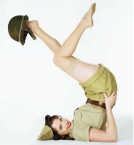Cuttlefish
Posts: 2454
Joined: 1/24/2007
From: Oregon, USA
Status: offline

|
September 20, 1943
Location: Kwajalein
Course: None
Attached to: Disbanded in port
Mission: None
System Damage: 0
Float Damage: 0
Fires: 0
Fuel: 475
Orders: Make preparations to sail
---
In the morning Chief Engineer Sakati seeks out Chief Petty Officer Shun. He finds him on the foredeck. As Sakati comes up Shun snaps to attention and gives him a crisp salute. The two men rarely interact, but they have served aboard Hibiki longer than anyone else on board and have a deep professional respect for one another.
“Relax, Chief,” says Sakati. “This is unofficial. I was ashore last night and picked up some news about the fighting around Noumea. There was one thing in particular I wanted to tell you. It seems that our aircraft confirmed sinking the American heavy cruiser Astoria there yesterday.”
Shun’s face, as usual, betrays no expression, but he gives the engineer his full attention. “I am sorry to hear that, sir,” he says. “That was a good ship.”
Sakati nods. “Indeed,” he says. “A good friend once, and I am sure a formidable foe.” He pauses. “One wishes sometimes that everything had turned out differently.” Shun nods. Both men are silent for a moment, their thoughts on the past.
---
It is April, 1939. Four warships slice westward across the Pacific, heading towards Japan. They are the American heavy cruiser Astoria and the Japanese destroyers Sagiri, Akatsuki, and Hibiki. Aboard Astoria is an urn containing the ashes of the former Japanese ambassador to the United States, Hiroshi Saito. Astoria has carried the urn all the way from Annapolis, and is now on the final leg of her long journey.
The voyage will turn out to be a public relations triumph. The Japanese are deeply moved by the honor done them by Astoria, and her captain and crew are gracious guests. Sakati and Shun are among a group of Japanese from the escorting destroyers invited to tour the cruiser, and both are impressed by the American ship. Shun especially notes the efficiency and professionalism of the crew, while Sakati is struck by the fact that the engine rooms are the cleanest he has ever seen.
The fellowship and good feeling generated by the voyage, sadly, are quickly dissipated over the next two years, as the two nations edge ever closer to war. Now, more than four years later, such a gesture of mutual honor and respect seems very far away indeed.
---
“I wonder if Turner was still in command,” says Shun after a moment. Captain Richmond Turner had greatly impressed the Japanese during Astoria’s visit.
“There is no way to know,” says Sakati. Shun nods. He ponders for a moment, then speaks.
“Do you remember the song?” he asks, then surprises Sakati by reciting it in his gruff voice.
“Welcome you men with hearts so true
America's best--America's pride
You show that though the winds blow
That peace and goodwill the storm can ride.”
Sakati remembers it. “Not exactly prophetic, was it, Chief?” he says.
“No sir,” says Shun.
---
Sailors from Astoria carry Ambassador Saito’s ashes ashore at Yokohama, April 17 1939:

 Attachment (1) Attachment (1)
|
 Printable Version
Printable Version













 .
. 









 New Messages
New Messages No New Messages
No New Messages Hot Topic w/ New Messages
Hot Topic w/ New Messages Hot Topic w/o New Messages
Hot Topic w/o New Messages Locked w/ New Messages
Locked w/ New Messages Locked w/o New Messages
Locked w/o New Messages Post New Thread
Post New Thread